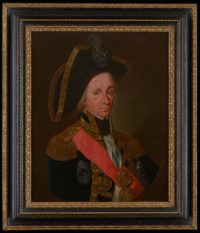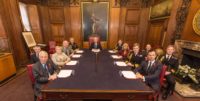 A portrait of Admiral Horatio Nelson depicting his war wounds in all their unvarnished glory has been rediscovered after 100 years out of public view and knowledge in private collections. It will go on display at Philip Mould & Company’s Pall Mall gallery starting November 13th. To celebrate its return, it will be displayed next to meticulous replicas of the fanciest accessories depicted in the painting: Admiral Nelson’s iconic bicorne hat, recreated according to his precise instructions Lock & Co. Hatters of St James’s who made the original hat by Nelson’s commission, and the still-lost Chelengk jewel very conspicuously pinned to the front of the hat in the portrait.
A portrait of Admiral Horatio Nelson depicting his war wounds in all their unvarnished glory has been rediscovered after 100 years out of public view and knowledge in private collections. It will go on display at Philip Mould & Company’s Pall Mall gallery starting November 13th. To celebrate its return, it will be displayed next to meticulous replicas of the fanciest accessories depicted in the painting: Admiral Nelson’s iconic bicorne hat, recreated according to his precise instructions Lock & Co. Hatters of St James’s who made the original hat by Nelson’s commission, and the still-lost Chelengk jewel very conspicuously pinned to the front of the hat in the portrait.
It was painted in 1799 by Leonardo Guzzardi, an artist at the court of Queen Maria Carolina and King Ferdinand of Naples and Sicily. Maria Carolina, 13th child of the formidable Empress Maria Theresa and Emperor Francis I of Austria, sister to Marie Antoinette of France, was a great patron of the arts and had a particular fangirl admiration for Admiral Nelson. She herself may have commissioned Guzzardi to capture Nelson’s likeness when the hero, painter and monarchs were in Palermo after their majesties’ hasty departure from Naples with French troops hot on their heels. It wouldn’t be the first time she’d sought a portrait of the admiral. Earlier in Naples she had told her son she’d have a portrait painted of Nelson so he could stand under it every day and say “Dear Nelson, teach me to be like you.” (Maria Carolina had a lot in common with her mother.)
In this portrait Nelson is emaciated and battle worn, with a scarred head, a missing arm (undetectable in the rendering), a blood-shot eye, and largely missing eyebrow. The portrait is uncompromising, so much so that one past owner, no doubt discomforted by the broken eyebrow, had it painted in to match that on the right. The wound had happened during the heat of engagement with the French at the Battle of the Nile at Aboukir Bay in Egypt in August 1798, whilst standing on the quarter deck with Edward Berry. A shard of iron struck Nelson’s forehead, slicing the skin and leaving an inch of skull visible. The piece of flesh, cut at jagged angles as seen in this portrait, hung down over his right eye, leaving him momentarily blinded. Such was the shock that Nelson, caught in the arms of Berry, famously cried out “I am killed. Remember me to my wife”. He was taken below deck, where the surgeon treated the wound with adhesive strips and gave Nelson opium to reduce the pain. His treatment, however, was supposedly interrupted by news that the French flagship L’Orient was on fire, at which moment Nelson ran back up on deck. This moment is captured by a theatrical portrait attributed to Guy Head [National Maritime Museum, Greenwich, BHC2903], in which Nelson is shown on deck with a burning ship beyond, blood dripping from his bandage onto the shoulder of his white shirt. The injury left Nelson disorientated and severely concussed, and the pain of the wound was such that he was forced to wear his hat tilted back, as seen in the present work, for some months.
Positioned conspicuously on top of his hat is the legendary Chelengk jewel. The jewel, made of diamonds, was gifted to Nelson by the Grand Sultan Selim III on 13 December 1798, in appreciation for saving Aboukir Bay (then part of the Ottoman Empire) from assault by Napoleon. The impressive jewel attracted wonder but also adverse comment, especially when Nelson took to wearing it – unofficially – on his naval uniform hat in a show of undaunted vanity. The gift also included a scarlet pelisse lined with sable fur and two thousand sequins (a type of small gold coin), to be shared amongst the wounded.
All of Guzzardi’s portraits of Nelson derive from a single head-type painted in early 1799 in Palermo, where the artist and subject had flown following the Jacobin revolt in Naples in December 1798. Guzzardi, about whom very little is known, was described at the time as a ‘Celebrated Artist at Palermo, Portrait Painter to the King’, and although few of his works have survived, the existing examples reveal a highly distinctive style with a preoccupation for vivid flesh tones, bold colouring and sharp treatment of facial features.
 The first painting Guzzardi did of Nelson was a full-length portrait depicting him in the full dress uniform of a rear admiral. He stands in the foreground on the deck of a ship, his left hand pointing in a weirdly awkward way towards a naval battle behind him on the right, a representation of the Battle of the Nile. The scarlet pelisse is draped over a chair under his pointing finger and the Chelengk jewel takes up half the front of his pushed-back hat.
The first painting Guzzardi did of Nelson was a full-length portrait depicting him in the full dress uniform of a rear admiral. He stands in the foreground on the deck of a ship, his left hand pointing in a weirdly awkward way towards a naval battle behind him on the right, a representation of the Battle of the Nile. The scarlet pelisse is draped over a chair under his pointing finger and the Chelengk jewel takes up half the front of his pushed-back hat.
There are 14 replicas of this portrait known to exist, some painted by Guzzardi, and the group can be split into two according to the admiral’s accessories. In the first iteration, he wears only the insignia of the Order of the Bath and the St Vincent naval medal around his neck. The later works include the star of the Turkish Order of the Crescent, a private issue gold medal for the Battle of the Nile and the official naval gold medal for the Battle of the Nile. While the newly rediscovered painting has the full complement of medals, experts believe they were later additions, that this portrait is one of the early group.
Art historians have known about this particular version of the portrait from archival records and photographs, but the last time its location was known was 1897 when it was documented in the collection of Alfred Morrison, an avid collector of Nelsoniana. He had bought it from Thomas Gullick, a London art dealer who had found the painting rolled up and gathering dust somewhere in Italy in the early 1880s. Even though less than a century had passed since it was painted, and even though the sitter has some very unique distinguishing features and was once one of the most famous people in the world, both the artist and the subject were unknown at that time. Gullick identified it right quick and tried to sell it to Earl Nelson (he passed) and the National Portrait Gallery (they also passed).
Morrison’s vast collection was broken up and sold by his widow. Some pieces went up for auction, others were sold privately. There are extant records of these sales but none of them mention this painting. It made its way to the United States where it was acquired by George M. Juergens of New York. A friend of the family bought it after Juergens’s death in 1987. That friend still owns it today. It seems he’s willing to sell it, however, as Philip Mould & Company is accepting purchase inquiries.
A pity, my sequin-covered underpants are not the gold coin variety…
When we were in North Norfolk recently we saw signs by the road telling us we were in “Nelson Country”. Hey ho.
More charmingly there were road signs in local English. “Slow you down”.